At Chia Chinese, we believe that learning a language should be a joyful, immersive experience. One of the most powerful tools we use in our classrooms is interactive storytelling, a method that goes beyond passive listening and engages students through role-playing, movement, open-ended questions, and hands-on activities.
Why do we use interactive storytelling? Because research shows that active engagement leads to deeper learning. When children participate in a story—rather than just listening to it—they retain new vocabulary more effectively, develop stronger speaking skills, and build confidence in using the language in real-life contexts.
Today, I want to take you inside one of our classrooms and show you exactly how we use this method to teach Chinese. The story? A birthday party—a simple five-page narrative that becomes an exciting, language-rich experience through creative interaction.
A Birthday Story—More Than Just a Story
At first glance, this five-page book might seem like a simple, straightforward story about a birthday celebration. But within these pages, we weave in three highly engaging interactive activities, ensuring that every student is an active participant in the story.
Meeting the Birthday Grandpa
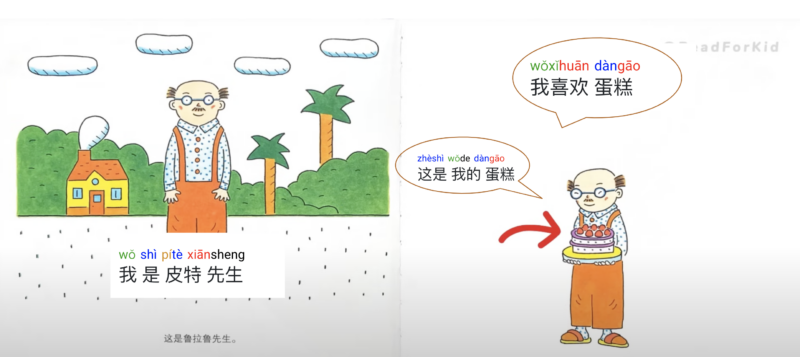
The story begins with the introduction of our main character: an elderly man celebrating his birthday. Instead of just describing the character, the teacher transforms into him—putting on a fake mustache, changing their voice to sound older, and greeting the students in a deep, warm tone:
Teacher (as Grandpa): “你好,孩子们!” (Hello, children!)
This immediately grabs the students’ attention. They giggle, surprised and excited to meet this new “character” in their classroom. The teacher then encourages them to greet him in return:
Students: “您好,皮特先生!” (Hello, Mr. Pete!)
💡 Why it works: By physically and vocally embodying the character, the teacher creates an immersive experience where students naturally respond in Chinese. It also reinforces cultural aspects of politeness and respectful greetings.
What Do You See? Observing and Describing
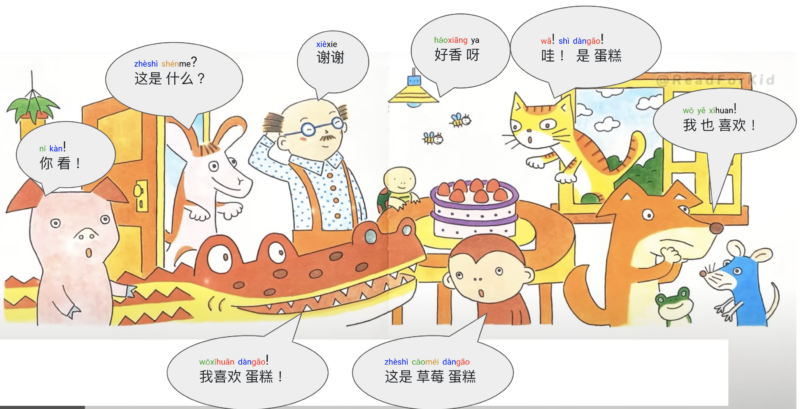
The second page of the story introduces the setting: a lively birthday scene filled with decorations, gifts, and guests—including different animals. Instead of simply narrating, the teacher pauses and asks an open-ended question:
Teacher: “你们看到什么?” (What do you see?)
To guide students in their responses, the teacher provides sentence starters on the board:
- 我看到… (I see…)
- 有… (There is/are…)
As students explore the page, they start making observations:
- “我看到一个蛋糕!” (I see a cake!)
- “有很多气球!” (There are many balloons!)
- “我看到一只猫!” (I see a cat!)
To make it even more engaging, the teacher adds an auditory element:
🐶 If students see a dog in the illustration, the teacher mimics a barking sound.
🐱 If they see a cat, the teacher meows.
🦉 If they see an owl, the teacher hoots.
Students imitate the sounds, and the teacher picks the best imitation, giving it a fun competitive edge.
💡 Why it works: This activity encourages natural language production without pressure, builds observation skills, and engages multiple senses, making the vocabulary more memorable.
The Gift Exchange—A Funny Surprise!
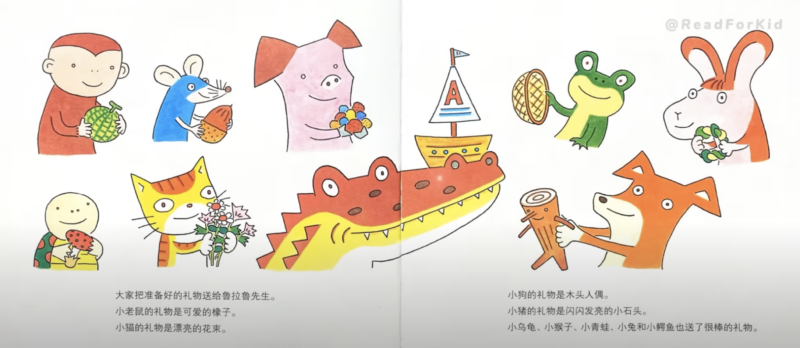
Now comes a crucial moment in the story: gift-giving. Our goal here is to teach the phrase:
- “这是你的礼物!” (This is your gift!)
- “哇!我喜欢!谢谢!” (Wow! I like it! Thank you!)
But instead of just repeating phrases, we turn it into an interactive game. The teacher wraps random everyday objects—things that don’t look like gifts at all—such as:
🎁 A leaf
🎁 A wooden stick
🎁 A plastic spoon
🎁 A straw
Each gift is beautifully wrapped to create an element of surprise. One by one, students come up to the front, while the rest of the class chants in unison:
“这是你的礼物!” (This is your gift!)
The student in front eagerly unwraps their mystery present, only to find…a leaf! A mix of surprise and laughter fills the room. The student then responds dramatically:
“哇!我喜欢!谢谢!” (Wow! I like it! Thank you!)
💡 Why it works: This playful activity reinforces real-life conversational Chinese while making students laugh, ensuring they’ll never forget the sentence structures. It also encourages spontaneous reactions, making their responses more authentic.
Blowing Out the Candles—A Magical Trick!
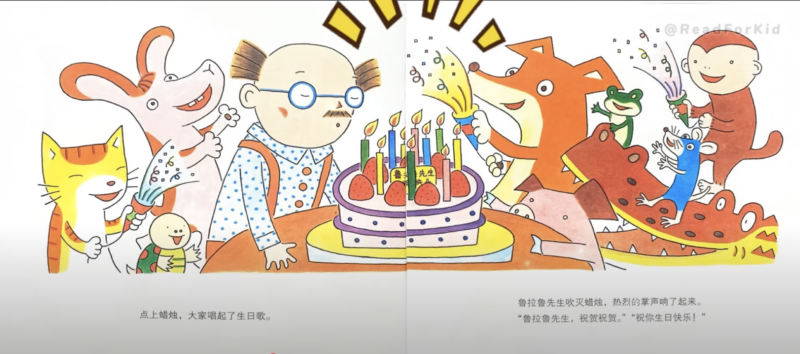
No birthday is complete without a birthday cake! The story shows the birthday grandpa blowing out candles, and we turn this into a hands-on, imaginative activity.
Since we don’t have real candles in class, the teacher draws simple candle illustrations on tissue paper and holds them up in front of students. Then, with great enthusiasm, the teacher says:
“吹蜡烛!” (Blow out the candles!)
One by one, the students take turns pretending to blow out the candles. Since tissue paper is lightweight, their breath actually makes the “candles” move, making it feel surprisingly real!
💡 Why it works: This simple trick brings imagination to life. It makes learning tactile, connects language to action, and adds an exciting physical element to storytelling.
Wrapping Up—Review and Reflection
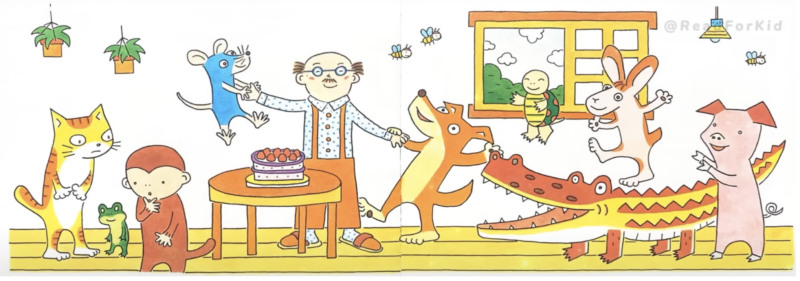
As we reach the last page, we bring everything together. The teacher leads a group discussion:
Teacher: “你们今天做了什么?” (What did you do today?)
The class responds enthusiastically:
- “过生日!” (We celebrated a birthday!)
- “吹蜡烛!” (We blew out the candles!)
- “送礼物!” (We gave gifts!)
The teacher then highlights three key vocabulary words on the board:
🎂 蛋糕 (Cake)
🕯️ 蜡烛 (Candle)
🎁 礼物 (Gift)
To check comprehension, the teacher challenges students to make sentences using these words, reinforcing their learning.
💡 Why it works: Ending with a review ensures retention. Students not only remember the words but also use them in full sentences, demonstrating active learning.
The Big Picture:Why Interactive Storytelling Works
Through just 15 minutes of storytelling, students have:
✅ Learned and used new vocabulary naturally
✅ Developed listening and speaking skills in a fun, low-pressure way
✅ Engaged in meaningful, real-world interactions in Chinese
✅ Strengthened memory retention through hands-on activities
At Chia Chinese, we believe that stories are not just for listening—they’re for experiencing. Through interactive storytelling, our students aren’t just learning Chinese; they’re living it!
Would you like to see this in action? Come visit our classroom and join in the fun!
What do you think? Have you tried interactive storytelling at home? Let us know in the comments!





